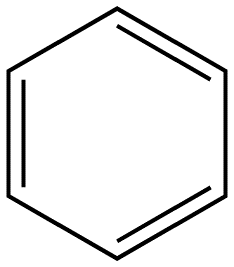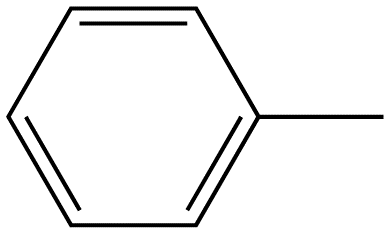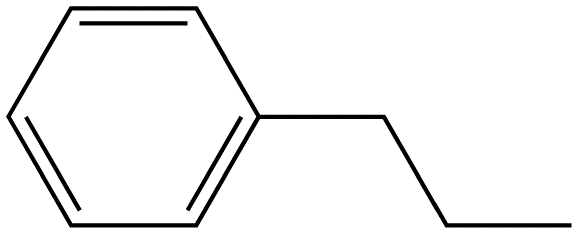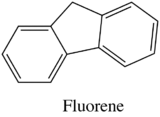
- •Introduction
- •Excited States Produces Fluorescence and Phosphorescence
- •Electron Spin
- •Photoluminescent Energy Level Diagrams
- •Absorption and Emission Rates
- •Deactivation Processes
- •Vibrational Relaxation
- •Internal Conversion
- •External Conversion
- •Intersystem Crossing
- •Phosphorescence
- •Variables that affect Fluorescence
- •Quantum Yield
- •Transition Types in Fluorescence
- •Quantum Efficiency and Transition Types
- •Fluorescence and Structure
- •Effect of pH on Fluorescence
- •Effects of Concentration on Fluorescence Intensity
- •Quenching Methods
- •Emission and Excitation Spectra
Fluorescence and Structure
The most intense fluorescence is found in compounds containing aromatic group with low-energy π→π∗ transitions. A few aliphatic, alicyclic carbonyl, and highly conjugated double-bond structures also exhibit fluorescence as well. Most unsubstituted aromatic hydrocarbons fluoresce in solution too. The quantum efficiency increases as the number of rings and the degree of condensation increases. Simple heterocycles such as the structures listed below do not exhibit fluorescence.
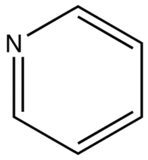
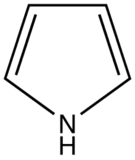
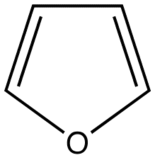
 Pyridine
Pyrrole
Furan
Thiophene
Pyridine
Pyrrole
Furan
Thiophene
With nitrogen heterocyclics, the lowest energy transitions is involved in n→π∗ system that rapidly converts to the triplet state and prevents fluorescence. Although simple heterocyclics do not fluoresce, fused-ring structures do. For instance, a fusion of a benzene ring to a hetercyclic structure results in an increase in molar absorptivity of the absorption band. The lifetime of the excited state in fused structure and fluorescence is observed. Examples of fluorescent compounds is shown below.
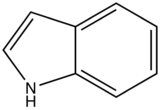
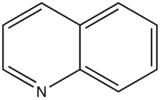

quinoline
Benzene ring substitution causes a shift in the absorption maxima of the wavelength and changes in fluorescence emission. The table below is used to demonstrate and visually show that as benzene is substituted with increasing methyl addition, the relative intensity of fluorescence increases.
Compound |
Structure |
Wavelength of Fluorescence (nm) |
Relative intensity of Fluorescence |
Benzene |
|
270-310
|
10
|
Toluene
|
|
270-320 |
17 |
Propyl Benzene |
|
270-320 |
17 |
Table 2. Relative intensity of fluorescence comparison with alkane substituted benzenes.
The relative intensity of fluorescence increases as oxygenated species increases in substitution. The values for such increase is demonstrated in the table below.
Compound |
Structure
|
Wavelength of Fluorescence (nm)
|
Relative intensity of Fluorescence |
Phenol
|
|
285-365
|
18
|
Phenolate ion |
|
310-400 |
10
|
Anisole
|
|
285-345
|
20
|
Table 3. Relative intensity of fluorescence comparison with benzene with oxygenated substituted benzene
Influence of a halogen substitution decreases fluorescence as the molar mass of the halogen increases. This is an example of the “heavy atom effect” which suggest that the probability of intersystem crossing increases as the size of the molecule increases. As demonstrated in the table below, as the molar mass of the substituted compound increases, the relative intensity of the fluorescence decreases.
Compound |
Structure |
Wavelength of Fluorescence (nm) |
Relative intensity of Fluorescence |
Fluorobenzene
|
|
270-320 |
10
|
Chlorobenzene
|
|
275-345
|
7
|
Bromobenzene
|
|
290-380
|
5
|
Table 4. Relative intensity fluorescence comparison with halogen substituted compounds
In heavy atom substitution such as nitro derivatives or heavy halogen substitution such as iodobenzene, the compounds are subject to predissociation. These compounds have bonds that easily rupture that can then absorb excitation energy and go through internal conversion. Therefore, the relative intensity of fluorescence and fluorescent wavelength is not observed and this is demonstrated in the table below.
Compound
|
Structure |
Wavelength of Fluorescence (nm)
|
Relative intensity of Fluorescence |
Iodobenzene
|
|
None
|
0
|
Anilinium ion
|
|
None
|
0
|
Nitrobenzene
|
|
None
|
0
|
Table 5. Relative fluorescent intensities of iodobenzene and nitro derivative compounds
Carboxylic
acid or carbonyl group on aromatic ring generally inhibits
fluorescence since the energy of the ![]() transition
is less than
transition
is less than ![]() transition. Therefore,
the fluorescence yield from
transition
is low.
transition. Therefore,
the fluorescence yield from
transition
is low.
Compound
|
Structure
|
Wavelength of Fluorescence (nm)
|
Relative intensity of Fluorescence
|
Benzoic Acid
|
|
310-390
|
3
|
Table 6. Relative fluorescent intensity of benzoic acid
Effect of Structural Rigidity on Fluorescence
Fluorescence is particularly favored in molecules with rigid structures. The table below compares the quantum efficiencies of fluorine and biphenyl which are both similar in structure that there is a bond between the two benzene group. The difference is that fluorene is more rigid from the addition methylene bridging group. By looking at the table below, rigid fluorene has a higher quantum efficiency than unrigid biphenyl which indicates that fluorescence is favored in rigid molecules.
Compound |
Structure |
Quantum Efficiency
|
Fluorene
|
|
1.0
|
Biphenyl
|
|
0.2
|
Table 7. Quantum Efficiencies in Rigid vs. Nonrigid structures
This concept of rigidity was used to explain the increase in fluorescence of organic chelating agent when the compound is complexed with a metal ion. The fluorescence intensity of 8-hydroxyquinoline is much less than its zinc complex.
 vs
vs
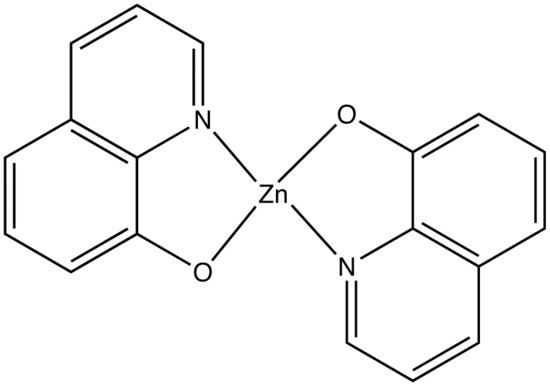
8-hydroxyquinoline 8-hydroxyquinoline with Zinc complexed
The explanation for lower quantum efficiency or lack of rigidity in caused by the enhanced internal conversion rate (kic) which increases the probability that there will be radiationless deactivation. Nonrigid molecules can also undergo low-frequency vibration which accounts for small energy loss.
Temperature and Solvent Effects
Quantum efficiency of Fluorescence decreases with increasing temperature. As the temperature increases, the frequency of the collision increases which increases the probability of deactivation by external conversion. Solvents with lower viscosity have higher possibility of deactivation by external conversion. Fluorescence of a molecule decreases when its solvent contains heavy atoms such as carbon tetrabromide and ethyl iodide, or when heavy atoms are substituted into the fluorescing compound. Orbital spin interaction result from an increase in the rate of triplet formation, which decreases the possibility of fluorescence. Heavy atoms are usually incorporated into solvent to enhance phosphorescence.

